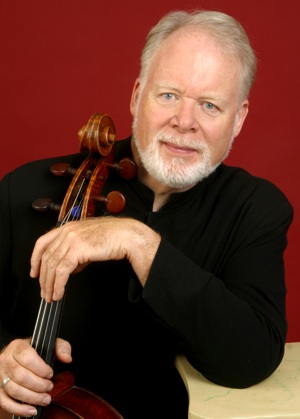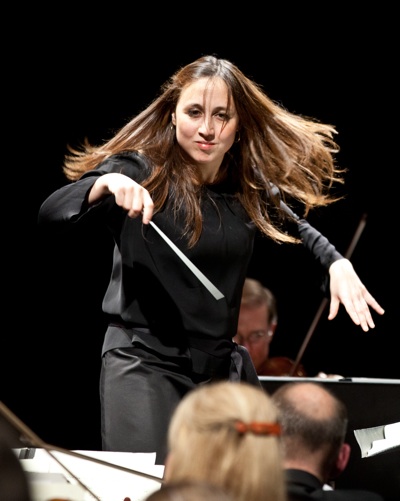Cello artistry and mugging…
Finding the sweet spot in a program that mixed nostalgia with bitter cynicism would tax most conductors, but Joana Carneiro energetically led the Berkeley Symphony through that confusing vale last Thursday, Feb. 7 at Zellerbach Auditorium.
What they achieved was luminously coloristic.
They eased into those back-and-forth emotional demands with the world premiere of Alfama by Andreia Pinto-Correia, the center movement of a triptych dedicated to the streets of Lisbon.
High shimmers and low murmurs evoked a diaphanous weave with a metallic luster. Often empty in the middle, the composer suspended horn notes that were dense as pebbles between string tremolos and the glitter of percussion. Carefully avoiding melody, rhythm or harmony, this work was gestural and meditative.

Speaking from the podium, Pinto-Correia described her memories of Alfama, an ancient neighborhood of Lisbon. “It is a Proustian approach… with water everywhere underneath. There are Romans, Visigoths, Arabs. And then it vanishes into thin air as if it fades from memory.”
This was a nice warm-up for the headliner, Witold Lutoslawski’s Concerto for Cello and Orchestra, a bitter yet also sharply coloristic work that was built around a unique tone row and lots of semitones. Cellist Lynn Harrell tossed off brilliant runs, then mugged during the mono-tonal elements, an oddly pop-star performance that tried to humor the audience as well as compel them.
The concerto began with repeated notes that are marked to be played disinterestedly. That note is an open string, and so cannot have vibrato or movement, other than that imparted by the bowing, which was bleak. Written during a period of official scrutiny and artistic and political repression, Lutoslawski may have been creating a neutral bedrock, the unbearable grays of Polish life under Russian rule. Harrell finally broke out of that repetition into a long and deeply felt soliloquy, returning periodically to that repeated D note. The orchestra finally came in with sharp trumpet accusations, perhaps an official reprimand, followed by a soft flurry of plucks and fingered timpani for a woodsy undercurrent, and then built back to menacing rebukes.
Written for Mstislav Rostropovich in 1970, this concerto’s difficulty and iconoclasm earned Lutoslawski many honors, later including the Solidarity Prize, and is now celebrated with a cello competition as well.
After a long ovation, Harrell returned for an encore. “I’d like to go back to a more innocent time in Polish history, to Chopin.”
Laden with the potent present, Harrell approached Poland’s past with bent notes and scoops, and with enormous runs tossed off as merely decorative. It was idiosyncratic and effective, and he ended on a pianissimo so attenuated there was a pause before anyone dared clap.
… and then, Rachmaninoff.
After intermission, they returned to present Sergei Rachmaninoff’s last major work, the Symphonic Dances, Op. 45. This was a hugely nostalgic attempt for the Russian émigré to return to the land of his youth, colored by hope and discolored by memory. Though it had less of the revelatory obsession of his earlier works, it was a gifted composer exercising a wide palette and control of coloration, with a language honed over his lifetime. The alto-sax solo in the first movement, performed by David Henderson, was extraordinary for its yearning beauty.
The second movement waltz was that curious fusion of visceral and ethereal. Between gentle billows of strings one could hear lush oboe solos performed by Deborah Shidler, Emma Moon’s liquid flute runs and exuberant clarinet exclamations from Roman Fukshansky. Then concertmaster Franklyn D’Antonio took a turn above the orchestra for his own heart-felt violin solo.
They gained a fevered quality in the final movement, rowing between rocky outcrops and languid shores. After the lovely solo work, it was also a treat to hear that ensemble sound, urgent and appreciative. Carneiro led with élan and sympathy, and the orchestra responded with a tribute to her and to the last of the romantics.
—Adam Broner
Photo top of cellist Lynn Harrell, by Christian Steiner; bottom, conductorJoana Carneiro, photo by Dave Weiland.
The Berkeley Symphony will conclude their season on March 28 in “The Idealists,” featuring a world premiere by this year’s composer-in-residence, Steven Stucky, paired with Bruckner’s Symphony No. 4. Preceding that, on March 24 one can also hear Stucky lead the Symphony in the last “Under Construction” concert, with three new works polished by three young composers. More information is available at www.berkeleysymphony.org
